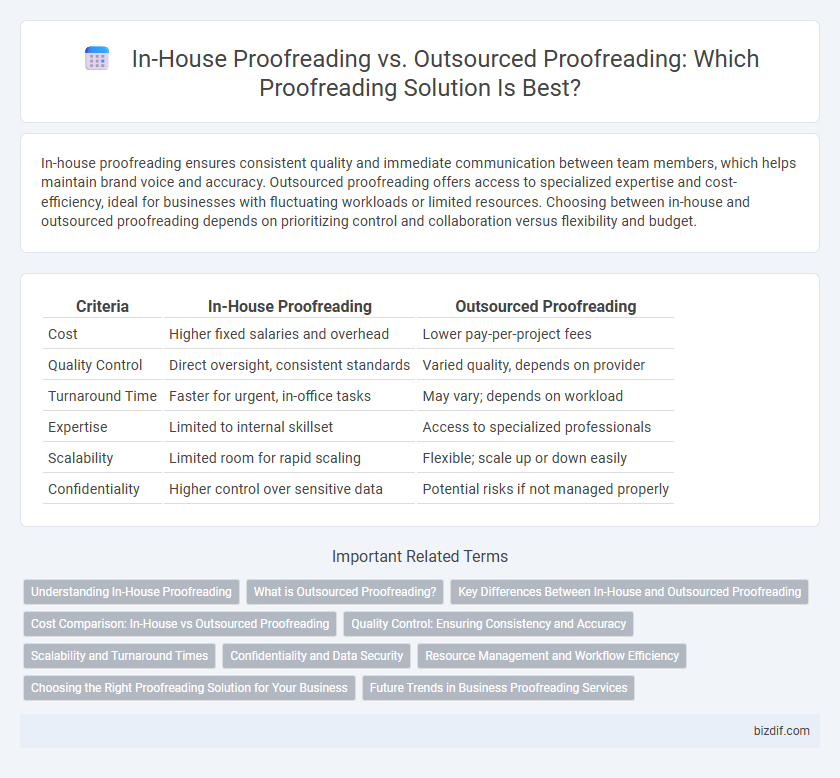In-house proofreading ensures consistent quality and immediate communication between team members, which helps maintain brand voice and accuracy. Outsourced proofreading offers access to specialized expertise and cost-efficiency, ideal for businesses with fluctuating workloads or limited resources. Choosing between in-house and outsourced proofreading depends on prioritizing control and collaboration versus flexibility and budget.
Table of Comparison
| Criteria | In-House Proofreading | Outsourced Proofreading |
|---|---|---|
| Cost | Higher fixed salaries and overhead | Lower pay-per-project fees |
| Quality Control | Direct oversight, consistent standards | Varied quality, depends on provider |
| Turnaround Time | Faster for urgent, in-office tasks | May vary; depends on workload |
| Expertise | Limited to internal skillset | Access to specialized professionals |
| Scalability | Limited room for rapid scaling | Flexible; scale up or down easily |
| Confidentiality | Higher control over sensitive data | Potential risks if not managed properly |
Understanding In-House Proofreading
In-house proofreading offers direct control over quality and consistency by utilizing proofreaders who are familiar with the company's style and terminology. This approach enables faster turnaround times and seamless communication within the team, ensuring alignment with specific project requirements. Investing in skilled in-house proofreaders can lead to improved accuracy and brand voice preservation across all content.
What is Outsourced Proofreading?
Outsourced proofreading involves delegating the review and correction of written content to external professionals or specialized agencies. This approach ensures access to expert linguists with diverse industry knowledge, enabling higher quality and faster turnaround times while reducing internal workload and costs. Businesses benefit from flexible scalability and specialized skills without the need for permanent in-house staff.
Key Differences Between In-House and Outsourced Proofreading
In-house proofreading involves dedicated staff working within a company's environment, ensuring immediate communication and alignment with brand voice and internal standards. Outsourced proofreading offers access to specialized expertise and scalability, often providing cost efficiencies for fluctuating workloads. Key differences include control over turnaround times, confidentiality levels, and integration with the existing workflow, where in-house teams typically provide faster feedback and tighter security, while outsourced services bring diverse industry experience and flexibility.
Cost Comparison: In-House vs Outsourced Proofreading
In-house proofreading typically incurs higher fixed costs due to salaries, benefits, and training expenses, while outsourced proofreading offers flexible pricing models based on project volume and complexity. Outsourcing reduces overhead by eliminating the need for permanent staff and office resources, making it a cost-effective solution for businesses with fluctuating proofreading demands. Comparing cost per word or project highlights that outsourced proofreading delivers scalable savings, especially for companies handling diverse or seasonal content workloads.
Quality Control: Ensuring Consistency and Accuracy
In-house proofreading offers direct oversight, enabling tighter quality control through immediate feedback loops and consistent application of brand-specific standards. Outsourced proofreading relies on external experts, which may introduce variability but can provide specialized skills and fresh perspectives. Ensuring accuracy and consistency demands clear communication of guidelines and rigorous review processes, regardless of whether proofreading is managed internally or externally.
Scalability and Turnaround Times
In-house proofreading offers direct control over workflow, but scalability can be limited by team size and available resources, potentially causing slower turnaround times during peak demand. Outsourced proofreading provides flexible scalability by accessing a larger pool of professionals, enabling faster turnaround times without compromising quality. Choosing between the two depends on balancing the need for rapid project completion with the importance of control and consistency in the proofreading process.
Confidentiality and Data Security
In-house proofreading offers enhanced confidentiality and data security by maintaining sensitive documents within the organization and limiting access to trusted employees. Outsourced proofreading may expose content to third-party risks despite contractual agreements and encryption methods. Companies handling proprietary or confidential information prioritize in-house services to mitigate potential data breaches and ensure strict compliance with internal security protocols.
Resource Management and Workflow Efficiency
In-house proofreading centralizes resource management, enabling direct communication and immediate feedback, which streamlines workflow efficiency and reduces turnaround times. Outsourced proofreading offers scalability and access to specialized expertise, but may introduce coordination delays and require more rigorous project tracking to maintain consistent quality. Balancing these factors ensures optimized resource allocation and seamless workflow integration tailored to project demands.
Choosing the Right Proofreading Solution for Your Business
Selecting the right proofreading solution hinges on your business's specific needs, budget, and turnaround time requirements. In-house proofreading offers direct control, immediate collaboration, and a deeper understanding of company style, while outsourced proofreading provides access to specialized expertise, scalability, and potential cost savings. Evaluating factors like document volume, confidentiality, and quality standards ensures you choose between in-house teams or trusted external providers that best align with your operational goals.
Future Trends in Business Proofreading Services
Future trends in business proofreading services indicate a growing preference for hybrid models combining in-house expertise with outsourced AI-driven solutions to enhance accuracy and efficiency. Advancements in natural language processing and machine learning enable outsourced services to provide real-time, scalable proofreading tailored to industry-specific terminology. Integrating these technologies with in-house teams fosters continuous improvement, cost-effectiveness, and faster turnaround times in document quality assurance.
in-house proofreading vs outsourced proofreading Infographic

 bizdif.com
bizdif.com